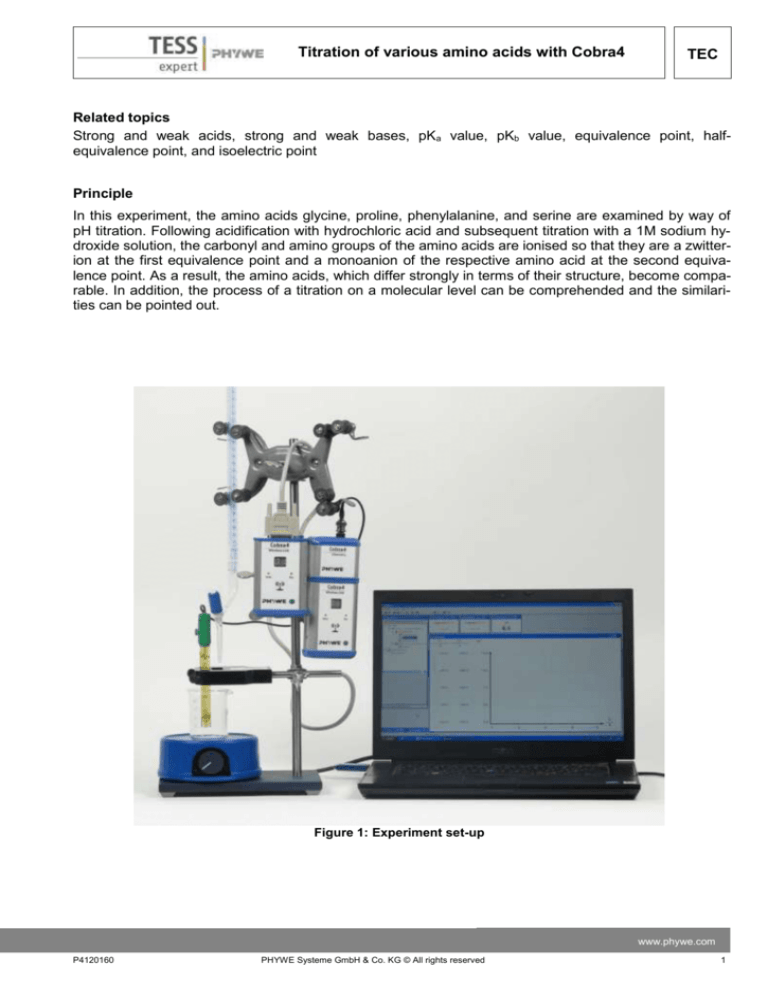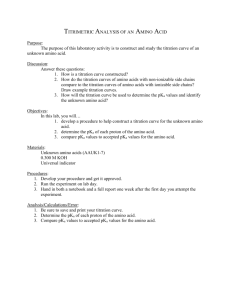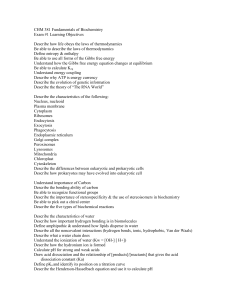
Titration of various amino acids with Cobra4
TEC
Related topics
Strong and weak acids, strong and weak bases, pKa value, pKb value, equivalence point, halfequivalence point, and isoelectric point
Principle
In this experiment, the amino acids glycine, proline, phenylalanine, and serine are examined by way of
pH titration. Following acidification with hydrochloric acid and subsequent titration with a 1M sodium hydroxide solution, the carbonyl and amino groups of the amino acids are ionised so that they are a zwitterion at the first equivalence point and a monoanion of the respective amino acid at the second equivalence point. As a result, the amino acids, which differ strongly in terms of their structure, become comparable. In addition, the process of a titration on a molecular level can be comprehended and the similarities can be pointed out.
Figure 1: Experiment set-up
www.phywe.com
P4120160
PHYWE Systeme GmbH & Co. KG © All rights reserved
1
TEC
Titration of various amino acids with Cobra4
Equipment
1
2
1
Cobra4 Wireless Manager
12600-00
Cobra4 Wireless-Link
12601-00
Drop counter
12636-00
Cobra4 Sensor-Unit Chemistry, pH,
12630-00
and 2 x Temperature NiCr-Ni
pH electrode, plastic, gel filling, BNC
46265-15
connector
"measure Cobra 4" software
14550-61
Holder for Cobra4 with a support rod 12680-00
Magnetic stirrer, mini, plastic, dark
47334-93
blue
Burette, 50 ml, graduation 0.1 ml
47151-01
Burette clamp with roller mounting 37720-01
Retort stand, 210 mm × 130 mm, h
37692-00
= 500 mm
Magnetic stirring bar 30 mm, cylin46299-02
drical
Boss head
37697-00
Beaker, 100 ml
46053-00
Set comprising a CPA 423S Sartorius precision balance and software, 49223-88
230 V, 4210 g/0.001 g
1
1
1
2
1
1
1
1
1
2
1
1
1
1
1
4
1
1
1
1
1
1
1
1
1
Microspoon
33393-00
Watch glass
34570-00
Funnel
34458-00
Volumetric flask, 50 ml
36547-00
Graduated pipette, 5 ml
36599-00
Pipettor
47127-01
Wash bottle, plastic, 500 ml
33931-00
Glycine (glycocoll), 100 g
31341-10
Buffer solution, pH 4.01, 1000 ml
46270-12
Buffer solution, pH 10.01,1000 ml 46272-12
Caustic soda solution, 1.0 m, 1000
48329-70
ml
Hydrochloric acid, 1.0 mol/l, 1000 ml 48454-70
Water, distilled, 5 l
31246-81
Additional equipment
PC, Windows® XP or higher
Phenylalanine
Serine
Proline
Water
Safety information
Always wear suitable protective gloves, safety goggles,
and suitable clothes when handling chemicals. The appendix includes detailed information concerning the
various chemicals.
Task
1. Record the titration curves of various amino acids and explain the individual sections.
2. Work out the differences and similarities between the amino acids.
Set-up and preparation
-
-
-
2
Set the experiment up as shown in Figure 1. This means the drop counter as well as the pH sensor must be connected to the computer via an own Wireless-Link and Wireless-Manager. Position the beaker on the magnetic stirrer and arrange the equipment so that the pH sensor as well
as the tip of burette aim into the beaker through the drop counter.
Prepare 50 ml of an acidified amino acid solution (c HCl = c amino acid = 0.1 mol/L). To do so, weigh
in succession 0.378 g of glycine, 0.826 g of phenylalanine, 0.576 g of proline, and 0.525 g of serine. Fill each of these amino acids into its own volumetric flask via a funnel.
Add 50 ml of the 1M hydrochloric acid into the volumetric flasks and top them up to 50 ml.
The amino acids should be completely dissolved.
Put the magnetic stirrer bar into the beaker (100 ml), add the content of one of the volumetric
flasks, and place the beaker on the magnetic stirrer and switch the magnetic stirrer on.
PHYWE Systeme GmbH & Co. KG © All rights reserved
P4120160
Titration of various amino acids with Cobra4
-
TEC
Fill the burette via a funnel with 20 ml of the 1M sodium hydroxide solution. Prior to doing so,
check whether the stopcock of the burette is closed.
Procedure
-
-
-
Start the PC and Windows.
Connect the Cobra4 Wireless Manager to the USB
port of the PC.
Start the "measure" software package on the PC.
Attach the Cobra4 Sensor-Unit Chemistry to the Cobra4 Wireless-Link and connect it to the pH electrode.
Tip: As an alternative to the Sensor-Unit Chemistry, it
is also possible to use the Sensor-Unit pH.
Connect the drop counter to the second Cobra4 Wireless-Link.
Switch the two Wireless-Links on and wait until the
program identifies the measurement sensor. Select
"Unknown titration volume" via the drop counter overview (see Figure 2).
The program will automatically create the virtual channel for the determination of the volume.
Prior to the start of the experiment, the temperature
inputs of the Cobra4 Sensor-Unit Chemistry must be
deactivated. To do so, select "Temperature T1" and
then "Temperature T2" in the "Navigator" and switch
them to "inactive" by deselecting the active field (see Figure 2: Drop counter overview for adjusting the titration volume
-
-
-
-
-
Figure 3).
Start the measurement data recording process in
"measure" . Then, start the titration by carefully opening the stopcock of the burette. The dropping rate
should be low with one drop per second at maximum.
After the end of the titration, stop the measurement data recording process (
).
Enter the sodium hydroxide solution quantity that has
been used into the window that pops up and confirm
the value.
After the graph has been displayed, it will take some
time before the program completes the calculation of
the data and before the y-axis can be adapted accordingly (click the graph).
The pH value can then be plotted as a function of the
volume in "measure" (copy the data of the calculated
table → in "measure" → Measurement → Import
measurement values …).
Double-click the graph in order to change the axis la- Figure 3: Window of a temperature
bels.
measuring channel
Observations and results
www.phywe.com
P4120160
PHYWE Systeme GmbH & Co. KG © All rights reserved
3
TEC
Titration of various amino acids with Cobra4
Figure 5 shows the graph of the titration of glycine. The curves for proline, serine, and phenylalanine
have been recorded in the same manner. They can be seen in a completely evaluated manner in Figures 10, 11, 12, and 13.
Figure 4: Titration curve of glycine
Evaluation
The following points of the curve should be labelled:
- 1st pKa value
- 1st equivalence point (1st EP)
- 2nd pKa value
- 2nd equivalence point (2st EP)
To do so, click the button for the equivalence point determination on
the toolbar (see the arrow in Figure 5). Then, select all of the options
and close the window (Figure 5).
Figure 5: Top: Button for the
equivalence point calculation
Bottom: Tab for the equivalence
point calculation
The following section includes the explanation of a titration curve with two equivalence points based on
the example of glycine.
4
PHYWE Systeme GmbH & Co. KG © All rights reserved
P4120160
Titration of various amino acids with Cobra4
TEC
Figure 6: Schematic diagram of a titration curve with two EPs
At the start of the measurement, the amino acid is present in an acid environment. Due to this excess of
protons, the cation of the amino acid is formed (see Figure 7, area a).
O
O
carboxyl group
amino group
HO
N
+
+
H
H
H
+
HO
N
H
H
H
glycine cation
Figure 7: Amino acid at the start of the measurement
When the sodium hydroxide solution is added, the number of hydroxide ions increases, thereby leading
to the formation of the zwitterions of the amino acid. At the first equivalence point, all of the amino acid
molecules are present in the form of zwitterions (see Figure 7, area of the 1st EP).
O
H
O
H
+
O
N
H
+
HO
-
O
H
+
N
-
H
H
H
+
H
O
H
zwitterion
Figure 8: At the first equivalence point, the amino acid molecule is present in the form of a zwitterion
www.phywe.com
P4120160
PHYWE Systeme GmbH & Co. KG © All rights reserved
5
TEC
Titration of various amino acids with Cobra4
After the first equivalence point, there is an excess of hydroxide ions, causing the zwitterion to release a
proton, thereby forming water. The result is the glycinate monoanion (see Figure 7, area b).
O
O
O
-
H
+
+
HO
-
O
-
N
H
N
H
+
H
O
H
H
H
glycinate monoanion
Figure 9: After the first equivalence point, the amino acid molecule is present in the form of a monoanion
At the second equivalence point, all of the amino acid molecules are present in the form of glycinate
monoanions. From this point on, the pH value increases due to the continuing addition of hydroxide ions
(see Figure 7, area c).
At the equivalence point of an acid-base-titration, there are equivalent substance quantities of the acid
and base that are part of the titration.
The isoelectric point of a titration of amino acids is reached at the pH value that occurs when the number
of acid groups with a negative charge corresponds to the number of amino groups with a positive
charge. At this point, the total charge of the molecules is neutral.
Figure 10: Titration curve of glycine with the data for the pKa values and equivalence points
6
PHYWE Systeme GmbH & Co. KG © All rights reserved
P4120160
Titration of various amino acids with Cobra4
TEC
Figure 11: Titration curve of phenylalanine with the data for the pKa values and equivalence
points
Figure 12: Titration curve of proline with the data for the pKa values and equivalence points
www.phywe.com
P4120160
PHYWE Systeme GmbH & Co. KG © All rights reserved
7
TEC
Titration of various amino acids with Cobra4
Figure 13: Titration curve of serine with the data for the pKa values and equivalence points
8
PHYWE Systeme GmbH & Co. KG © All rights reserved
P4120160
Titration of various amino acids with Cobra4
TEC
Appendix
Hazard pictogram, signal word
Hazard information
Safety information
-
-
-
-
-
-
-
-
-
-
H314: Causes severe skin
burns and eye damage.
H335: May cause respiratory
irritation.
P261: Avoid breathing
dust/fume/gas/mist/vapours/
spray.
P280: Wear protective
gloves/protective clothing/eye
protection/face protection.
P305+P351+P338:
IF IN EYES:
Rinse cautiously with water for
several minutes. Remove contact lenses if present and easy
to do. Continue rinsing.
P310: Immediately call a POISON CENTRE or doctor/
physician.
H314: Causes severe skin
burns and eye damage.
P280: Wear protective
gloves/protective clothing/eye
protection/face protection.
P305+P351+P338:
IF IN EYES:
Rinse cautiously with water for
several minutes. Remove contact lenses if present and easy
to do. Continue rinsing.
P310: Immediately call a POISON CENTRE or doctor/
physician.
Water
Glycine
Phenylalanine
Serine
Proline
Hydrochloric acid
Danger
Sodium hydroxide solution
Danger
www.phywe.com
P4120160
PHYWE Systeme GmbH & Co. KG © All rights reserved
9
TEC
Titration of various amino acids with Cobra4
Room for notes:
10
PHYWE Systeme GmbH & Co. KG © All rights reserved
P4120160






